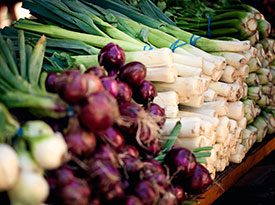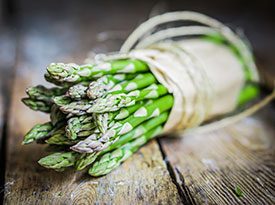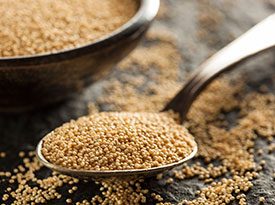
Wild Leeks
Why To Try: Also known as ramps, these members of the onion family tend to get a lot of attention for their antibacterial content. But if you’re saving wild leeks for cold and flu season, you’re missing out on their other benefits. Wild leeks also contain chronic-disease-fighting kaempferol, an antioxidant that research suggests may reduce the risk of cancer and cardiovascular disease by decreasing oxidative stress and fighting cancer-causing free radicals.
How to Try: Substitute wild leeks for half of the basil in your family’s favourite pesto recipe, then toss with pasta, smear on sandwiches or swirl into soups.

Asparagus
Why To Try: We know to fill up on these high-fibre stalks if we’re trying to cut calories and fat. But asparagus also provides a serious dose of folate and a powerful antioxidant called glutathione, both of which research suggests may help slow age-related cognitive and physical decline and the onset of disease.
How to Try: Cut calories and boost nutrition by substituting half your pasta with asparagus noodles. Shave stalks into strands using a vegetable peeler or mandolin, steam for three minutes until tender and top with your favourite pasta sauce.

Pasture-Raised or Omega-3 Eggs
Why To Try: We’ve always praised eggs as a vegetarian-friendly source of protein, but they also contain a lofty dose of eye-protecting antioxidants, including lutein and zeaxanthin. In one controlled study, eating just over one egg a day for about a month increased the body’s lutein levels by as much as 50 percent and zeaxanthin by as much as 142 percent. Although further research is needed to better understand how lutein interacts with the eyes, some studies have shown that elevated levels of this antioxidant may reduce the risk of age-related macular degeneration and cataracts.
How to Try: Whip up the classic Israeli one-pan breakfast called shakshuka (tomato sauce with lightly baked eggs). Simply simmer 1 diced bell pepper, with 1 onion, 3 cloves garlic, and 3 cups chopped canned tomatoes with 1 teaspoon each cumin and sweet paprika in an oven-safe pan. Top the mixture with 4 eggs and 2 ounces of crumbled feta. Bake at 375°F for 10 minutes until the egg whites are set. Serve with whole grain bread or pita.

Grass-Fed Milk
Why To Try: We all know to drink our milk for protection against osteoporosis, colon cancer and other diseases, but the grass-fed variety offers bonus benefits of heart-protecting conjugated linoleic acid and a much-needed extra dose of omega-3s. Research suggests that the average North American consumes as much as 16 times as many omega-6 fatty acids as omega-3s, due to our love of processed foods and refined oils, which may contribute to an increased risk of cardiovascular, autoimmune and inflammatory diseases.
How to Try: Brown 1 whole chicken in a Dutch oven, then cover it in 2 cups grass-fed milk with 4 cloves garlic and the zest of 2 lemons. Braise for 1 1/2 hours until tender and serve with the milky sauce.

Amaranth
Why To Try: Folks with celiac disease or gluten intolerance have long praised this whole grain as a gluten-free go-to. But with 26 grams of high-quality complete protein per cup, amaranth has muscle-supporting and satiating benefits for veg heads and carnivores alike.
How to Try: Toast 1/4 cup grains in a dry pan with another 1/3 cup of a combination of shaved coconut and seeds and nuts of your choice until the amaranth “pops” and turns golden brown. Layer on top of your morning yogurt and berry parfait for a satisfying crunch
